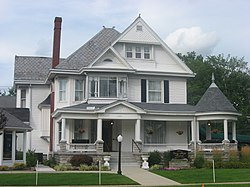United States historic place
| State Street Historic District | |
| U.S. National Register of Historic Places | |
| U.S. Historic district | |
 DSR Funeral Home, July 2012 DSR Funeral Home, July 2012 | |
  | |
| Location | Roughly bounded by Chestnut, Jackson, Jefferson, State Sts., North Vernon, Indiana |
|---|---|
| Coordinates | 39°00′04″N 85°37′24″W / 39.00111°N 85.62333°W / 39.00111; -85.62333 |
| Area | 24 acres (9.7 ha) |
| Built | 1853 (1853) |
| Architect | Barber, George F. |
| Architectural style | Queen Anne, Bungalow/craftsman, et al. |
| NRHP reference No. | 06001290 |
| Added to NRHP | January 25, 2007 |
State Street Historic District is a national historic district located at North Vernon, Jennings County, Indiana. It encompasses 75 contributing buildings and 4 contributing structures in a predominantly residential of North Vernon. The district developed between about 1852 and 1950, and includes notable examples of Queen Anne and Bungalow / American Craftsman style architecture. Notable contributing buildings include the First Baptist Church (1905), First Presbyterian Church (1871), Olcott House (now Dove, Sharp, and Rudicel Funeral Home, 1907), McGannon-Olcott House (c. 1868), Charles Watchell House (c. 1893), Frank Little House (c. 1898), Tripp / Verbarg House (c. 1891), and Joseph C. Cone House (c. 1894).
It was listed on the National Register of Historic Places in 2007.
References
- ^ "National Register Information System". National Register of Historic Places. National Park Service. July 9, 2010.
- "Indiana State Historic Architectural and Archaeological Research Database (SHAARD)" (Searchable database). Department of Natural Resources, Division of Historic Preservation and Archaeology. Retrieved May 1, 2016. Note: This includes Carol Ann Schweikert (March 2006). "National Register of Historic Places Inventory Nomination Form: State Street Historic District" (PDF). Retrieved May 1, 2016. and Accompanying photographs.
This article about a property in Jennings County, Indiana on the National Register of Historic Places is a stub. You can help Misplaced Pages by expanding it. |

